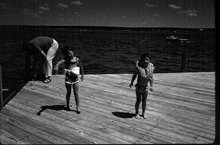"The scenery along the river is agreeable, with a pleasant alteration of gently sloping prairies and wooded creek bottoms," wrote Frederick Law Olmstead about Austin on his travels though Texas in the early 1850s. Traveling through the same region today one would be hard-pressed to make the same comment, save for a few parcels of land spared from the advance of development.
The yard guys showed up today, and my frustration at attempting to explain to them my almost futile attempts at restoration….actually, to even explain the difference between a particular grass that belongs to a specific plant community as opposed to one that does not. Armed with weed eaters and leaf blowers, they see any vegetation peering beyond the straightedge of the city's curb as violating a fundamental precept of landscape.
I do suspect, however, that in their own places of origin, their own human communities, many of them hold a similar, vague blueprint of the species belonging to their indigenous plant communities. The fourth graders at a local eastside elementary were similarly confused. We talked about words like habitat and ecosystem, yet these concepts were frozen in structural blocks, such as rocks, water, plants, air—the things that animals need to survive. Perhaps the idea of specific communities of plants and animals is beyond the fourth grade (although I don't think it should be), but they all seemed to readily associate the word ecosystem with the rainforest, and yet seemed confused that there were several invasive species located in a nearby riparian area that were detrimental to this ecosystem, even though they did not cause a rash when touched. It calls to mind something I read when studying for the certified arborist exam, that the primary reason for pruning trees are human reasons.
Over the last three years I have steadily removed the crabgrass, St Augustine, and annual grasses to allow the Stipa, the winter grass, to flourish. I suspect that it was this grass, not the buffalo grass that goes by the name "Mesquite grass" that Olmsted was referring to when he wrote, "The grass of the Eastern prairies is course and sedgy, like that of rank, moist, outlying spots in New England… Our animals showed no disposition to eat it." With only the slightest nod toward care, it flourished in my yard, and soon exceeded in beauty the Lindheimer muhly that I had paid real money for at a local native nursery. But today it is mowed to the ground like any weed around town that happened to sprout near the edge of a curb or walkway.
Restoration seems to be less of a straightforward business than one would think. After all, the world itself is engaged perpetually in process. We are forever reminded of this, and it is sometimes hard to justify the position that anything truly is indigenous to any particular place. I am not so naïve a purist, however, I appreciate an ever increasing (even if only my own) awareness of the relationships between the land and its vegetation, its communities plant and otherwise, and this great variable of climate. How do you explain, anyway, to a classroom of children, most of them immigrants from Mexico or South and Central America, that it is important to eradicate those species that have come from someplace else; that these species are so successful at outcompeting the ones that are indigenous to this region that the locals can no longer compete? Trying to explain why invasive species are bad for the nearby preserve made me feel a bit like a more educated version of Rush Limbaugh.
I have a particular, perhaps genetic, love of the prairie grass communities, for the post oak and the cottonwood, which not only sound like water when the wind blows through their leaves, but serve, like the sycamore, as indicator species for underground springs and water sources. Maybe in each of us there is a place where a vast expanse of undulating grass, periodically interrupted by wildflowers, corresponds. It is hard to get at this, here in a country where newly installed subdivisions come equipped with angular plots of grass appointed with a requisite number of shrubs and trees, all connected to an irrigation system as a hospital patient to an IV drip. The idea of the home has ceased to integrate with the idea of land, and certainly the word landscape, as Dean Fritz Steiner pointed out in his book Human Ecology, has been reduced to the most pedestrian terms. I think we need to rethink ecology. We need to introduce the idea of ecology as a question rather than a formula, an investigation for students, rather than a prescription.
But then what are we left with in the end? What was it that inspired Olmsted, after all? Certainly not the ecology, but the experience of landscape. The encounter with the sublime, with the formality of the geological and vegetative oeuvre, formed from the palette of his vast perception of these natural occurrences of species prior to the interfering hand of man. In the end perhaps we are all formalists, just slaves to differing ideals of form, some aesthetic, and some "scientific" but still operating our heads the same way our hands might wield leaf blowers.



